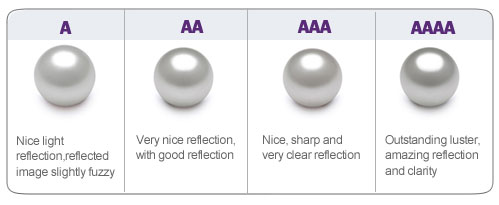A pearl is a hard, roundish object, composed of calcium carbonate, produced within the soft tissue of a living shelled mollusk. The ideal pearl is perfectly round and smooth, but many other shapes of pearls occur. Pearl is considered to be the birthstone for June.
There are essentially three types of pearls: natural, cultured and imitation.
A natural pearl, often called an Oriental pearl, forms when an irritant, such as a piece of sand, works its way into a particular species of oyster, mussel, or clam. As a defense mechanism, the mollusk secretes a fluid to coat the irritant. Layer upon layer of this coating is deposited on the irritant until a lustrous pearl is formed.
A cultured pearl undergoes the same process on a pearl farm. The only difference is that the irritant is a surgically implanted bead or piece of shell called Mother of Pearl. The great majority of pearls used for jewelry are cultured pearls. The pearls are usually harvested after one year for Akoya, 2-4 years for Tahitian and South Sea, and 2-7 years for freshwater.
In most cases, imitation pearls are made from a glass bead that is dipped into a solution made from fish scales. This coating is thin and may eventually wear off.
The value of the pearls in jewelry is determined by a combination of the luster, color, size, lack of surface flaw and symmetry that are appropriate for the type of pearl. Perfectly round pearls are the rarest and most valuable shape.
 Luster is the deep inner glow of the pearl and its brilliance to the human eye. For cultured pearl experts, this factor is perhaps the most important indicator in evaluating cultured pearl quality because it is what separates the ordinary from the extraordinary. The unique luster of pearls depends upon the reflection, refraction, and diffraction of light from the translucent layers. The thinner and more numerous the layers in the pearl, the finer the luster. Throughout history, this unique quality has separated pearls from all other gems and it is what many experts term the heart and soul of a pearl.
Luster is the deep inner glow of the pearl and its brilliance to the human eye. For cultured pearl experts, this factor is perhaps the most important indicator in evaluating cultured pearl quality because it is what separates the ordinary from the extraordinary. The unique luster of pearls depends upon the reflection, refraction, and diffraction of light from the translucent layers. The thinner and more numerous the layers in the pearl, the finer the luster. Throughout history, this unique quality has separated pearls from all other gems and it is what many experts term the heart and soul of a pearl.
 Surface quality refers specifically to the abundance or absence of physical blemishes. When evaluating surface, remember that cultured pearls are grown by live mollusks in nature. As such, there are many uncontrollable forces that affect the surface. The fewer the natural markings or spots on the pearl’s visible surface, the more expensive the pearl.
Surface quality refers specifically to the abundance or absence of physical blemishes. When evaluating surface, remember that cultured pearls are grown by live mollusks in nature. As such, there are many uncontrollable forces that affect the surface. The fewer the natural markings or spots on the pearl’s visible surface, the more expensive the pearl.
Pearls are very soft and need special care. They never should be tossed on top of or next to other gems in a jewelry box. Store them in a jewelry pouch, and wipe them with a soft cloth after wearing them.
Besides being soft, pearls are easily damaged by chemicals like perfume, vinegar, and lemon juice. Heat can turn pearls brown; dry them out and make them crack. Dry air can also damage pearls, so keeping them in a safe deposit box is not the best place for them.
• Only use jewelry cleaners labeled as safe for pearls.
• Never use an ultrasonic cleaner.
• Never steam-clean pearls.
• Never expose pearls to dish or wash detergents, bleaches, powdered cleansers, baking
soda, or ammonia-based cleaners (like Windex).
• Never use toothbrushes, scouring pads or abrasive materials to clean pearls.
• Do not wear pearls when the string is wet. Wet strings stretch and attract dirt, which is hard to remove.
• Do not hang pearls to dry.
• Take your pearls off when applying cosmetics, hair spray, and perfume, or when showering or swimming.
• Avoid wearing pearls with rough fabrics like Shetland wool.
• Have your pearls restrung once a year if you wear them often.
Cleaning Pearls
The best way to clean pearls is to soak them in warm water and a mild detergent such as Ivory soap. After you wear pearls, just wipe them off with a soft cloth or chamois, which may be dry or damp. This will prevent dirt from accumulating and keep perspiration, which is slightly acidic, from eating away at the pearl nacre. You can even use a drop of olive oil on the cloth to help maintain their luster.
